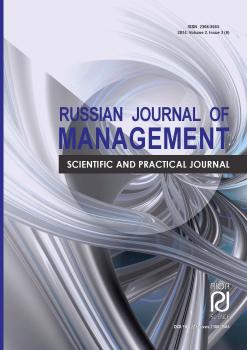Рязань, Рязанская область, Россия
Россия
ВАК 08.00.05 Экономика и управление народным хозяйством (по отраслям и сферам деятельности, в том числе: экономика, организация и управление предприятиями, отраслями, комплексами; управление инновациями; региональная экономика; логистика; экономика труда; экономика народонаселения и демография; экономика природопользования; экономика предпринимательства; маркетинг; менеджмент; ценообразование; экономическая безопасность; стандартизация и управление качеством продукции; землеустройство; рекреация и туризм)
ВАК 08.00.10 Финансы, денежное обращение и кредит
ВАК 08.00.12 Бухгалтерский учет, статистика
ВАК 08.00.13 Математические и инструментальные методы экономики
ВАК 08.00.14 Мировая экономика
УДК 330.1 Экономические науки. Основные понятия. Стоимость. Капитал.Фонды
ГРНТИ 06.00 ЭКОНОМИКА И ЭКОНОМИЧЕСКИЕ НАУКИ
ОКСО 38.00.00 Экономика и управление
ББК 6 ОБЩЕСТВЕННЫЕ НАУКИ
BISAC BUS BUSINESS & ECONOMICS
В статье представлены результаты анализа процессов взаимодействия производственных подразделений уголовно-исполнительной системы и представителей бизнес-сообщества. На основе официальных статистических проведен структурный анализ производственной деятельности пенитенциарных учреждений, а также особенностей их контрагентских отношений с представителями бизнес-сообщества. Обоснованы текущие тенденции и перспективные направления развития кооперационного взаимодействия пенитенциарных учреждений и предпринимательских структур в вопросах организации производства.
производственный сектор, трудовая адаптация, пенитенциарная система, экономическая безопасность, предпринимательство
INTRODUCTION
In conditions of global economic, fuel, food and epidemic crisis, merous secondary issues have receded into the background. Meanwhile, a fairly old, but periodically surfacing scientific discussion (from an economic standpoint) [14; 15], the problem of the labor organisation of persons serving sentences in places of deprivation of liberty during the pandemic has acquired quite specific outlines.
Against the background of the anti-crisis mode of functioning of the bulk of industrial enterprises, ensuring full and productive employment of convicts (that is, employment that allows not only to involve all able-bodied persons in socially useful activities, but also to ensure a decent result of work for all its participants) has become much more complicated. In turn, the solution of this problem causes the urgency of such important issues for society as compensation for damage to victims of crimes committed, as well as compensation for the costs of the state (i.e. taxpayers) for the convicts’ maintenance in deprivation of liberty places. This is not a complete list, it can be significantly expanded.
Crises and acute periods of change in public life often allow us to better see hidden problems, assess the impact of various factors from a new angle, and offer new solutions to them. Within the framework of this article, an attempt is made to look at the problem of the labor use of convicts from a somewhat unconventional perspective. Having only partially touched upon the general problematic (mainly regulatory) aspects of the functioning of correctional institutions (hereinafter CI) as business entities, we will focus on the microeconomic analysis of their interaction with business – potential and real subjects of demand for CI products.
It should also be taken into account the fact that the low level of convicts’ involvement in socially useful work and the very fact of the presence of penitentiary unemployment significantly reduces the correctional impact of labor, as one of the few means of correction available to the administration of the CI. In these conditions, there is an increase in recidivism. Minister of Justice of the Russian Federation Chuichenko K.A. in his report to Russian President Putin V.V., during a working meeting on 31.01.2022, identified as one of the ways to solve the problem of the low level of labor adaptation of convicts – an increase in the number of places in correctional centers by 100 thousand, as well as their filling by convicts to imprisonment, which, in accordance with the legislation, this type of punishment will be replaced by coercive works.
In this case, it should be borne in mind that, based on the data presented by the Deputy Director of the Federal Penitentiary Service of Russia A.I. Yakunin on 10.25.2021 during his speech at the Federation Council, out of 8.4 thousand people serving coercive works, only 2.4 thousand convicts are involved in labor. It is noteworthy that coercive works, as a type of punishment, was initially focused on the productive interaction of correctional centers and representatives of the business community. The adoption of Federal Law No. 179-FZ from 18.07.2019 "On Amendments to the Penal Code of the Russian Federation" was primarily aimed at creating conditions that allow private structures to actually create correctional centers on the basis of their property according to the formula "private production - state regime".
In the Concept of the development of the penal system until 2030, the issues of the development of the interaction of the business community with CI in order to increase convicts’ employment are considered from the point of view of improving the coercive works executing practice. Considering that among the 121 institutions executing coercive works in our country, 92 are isolated sections of institutions executing deprivation of liberty, it was also obviously assumed that the interaction of representatives of the business community with the penitentiary system would extend not only to the work of those sentenced to coercive works, but also to the activities of labor adaptation centers of correctional colonies. However, the excess of the level of penitentiary unemployment in correctional centers over the corresponding indicators of labor adaptation centers indicates that legislative innovations in terms of simplifying the procedures for interaction of the IU with private business have not had a corresponding impact. The level of cooperation between private business and the penitentiary system remains at an insufficient level.
Thus, the problem of identifying the features of the organization of interaction between the bodies and institutions of the penitentiary system with representatives of the business community in the process of convicts’ labor organizing is relevant and requires the application of appropriate scientific efforts.
ANALYSIS OF RECENT RESEARCH AND PUBLICATIONS
The study and comparative analysis of publications on the problems of interaction of CI with commercial structures on the issues of convicts’ labor organizing allows us to conclude that there is a disparity of opinions and the absence of a single vector of research.
A number of publications are devoted to the study of foreign (mainly American) experience in organizing production activities using convict labor in the format of a federal corporation, the possibilities and expediency of creating non-state (private) prisons [9; 12], consideration of the possibilities of using tools of borrowed labor (outstaffing) in in relation to convicts [4].
Other studies focus on the analysis of existing restrictions imposed on correctional institutions in the process of choosing areas of activity and subjects of cooperation (special access regime, low qualifications and insufficient motivation of convicts to work) [1]. At the same time, there are positions on the need to revive Soviet methods of convicts’ labor organizing [8].
Much attention of researchers is paid to considering the possibilities of non–economic, administrative ways to form a stable market niche for the products of correctional institutions (for example, by analogy with small businesses and socially oriented non-profit organizations, to establish a certain standard - a mandatory share of goods, works and services that should be purchased from CI to meet state and municipal needs) [5; 22].
The works devoted to the issues of participation of correctional institutions in industrial cooperation at the regional level, the analysis of possible organizational formats of cooperation are somewhat on the sidelines [3].
A significant number of publications are devoted to the problems of the development of public-private partnership in the organization of production on the basis of penitentiary institutions [2; 7; 5; 4, etc.).
Meanwhile, the postulate about the need to implement these projects is not sufficiently justified by the results of the analysis of the possibilities and limitations of cooperation, the assessment of emerging risks for each of the parties. Some researchers come to concrete conclusions that the use of public-private partnership tools in the criminal justice system is extremely limited, and the objects of the industrial sector of the penal system do not cause commercial interest in business [11].
Thus, it seems relevant to approach in detail the problem of identification and possible assessment of risks arising in the course of interaction (or initially hindering interaction) of business and IU, in order to provide more reasonably discussions about effective directions and forms of these entities cooperation on the basis of scientific findings.
MATERIALS AND METHODS OF RESEARCH
The purpose of the article was formed in response on two questions. First, what prevents business and CI from effectively interacting in the economic sphere in the existing legal field? And the second – where are the points of contact of the economic interests of the parties?
The answer to the first question makes it possible to identify and qualitatively assess the key risks that complicate the formation of rational economic relations between CI and business. The answer to the second question will allow us to determine the possible field of cooperation and corridors of opportunities that allow participants to implement their interests taking into account existing risks.
Some methodological feature of the study is the application in the process of analyzing the basic concepts and tools of the new institutional economic theory (we see the peculiarity of the study not in the fact of applying the provisions of the new institutional economic theory, but in the fact that the problem field – the economic relations of CI and business – is practically not considered in the scientific literature from these positions), first of all, the specificity of assets, limited rationality and opportunistic behavior [20].
The main information sources for analyzing the processes of interaction between the production sector of the penitentiary system and representatives of the business community are the statistics of the Federal Penitentiary Service of Russia. In particular, data on the volume of output of finished goods, works and services by the institutions of the penitentiary system, as well as their main consumers in 2018 – 2020 were used. In order to identify the features of the analyzed interaction, it was supposed to determine the ratio between: goods (as products made from raw materials purchased at their own expense) and works (including services, as products that do not have a pronounced material and raw material component in the cost structure). Also, the subject of the analysis was the categories of consumers of the products of the production sector of the penitentiary system in order to identify trends in the predominance of one of the three key groups:
- institutions and bodies of the penitentiary system;
- state and municipal procurement (excluding penitentiary system);
- commercial organizations.
This classification will allow us to identify the commercial segment of the product manufactured by CI, as well as to somewhat specify the form of the product that the business wants and receives from penitentiary system units.
RESEARCH RESULTS
According to the statistical reports of the Federal Penitentiary Service of Russia for the period from 2018 to 2020, the total volume of products produced with the involvement of convicts in paid labor (in actual prices) increased from 30.5 to 36.4 billion rubles (+19.3%).
The structure of products is traditionally dominated by goods, for 2018-2020 their volume increased from 19.6 to 22.1 billion rubles (+12.8%). It should be noted that the goods produced by CI are characterized by a sufficiently high material consumption, about 53-55% of their cost is formed due to the raw materials and components used.
The volume of works and services performed and rendered by CI, in terms of value for 2018-2020, increased more significantly – from 10.9 to 14.3 billion rubles (+31.2%).
Thus, we can talk about the "commodity-oriented" structure of products manufactured by the institutions of the penitentiary system (Fig. 1), which during the study period shifted slightly towards an increase in the share of works and services (the ratio of 64%/36% in 2018 shifted towards 61%/39% in 2020).
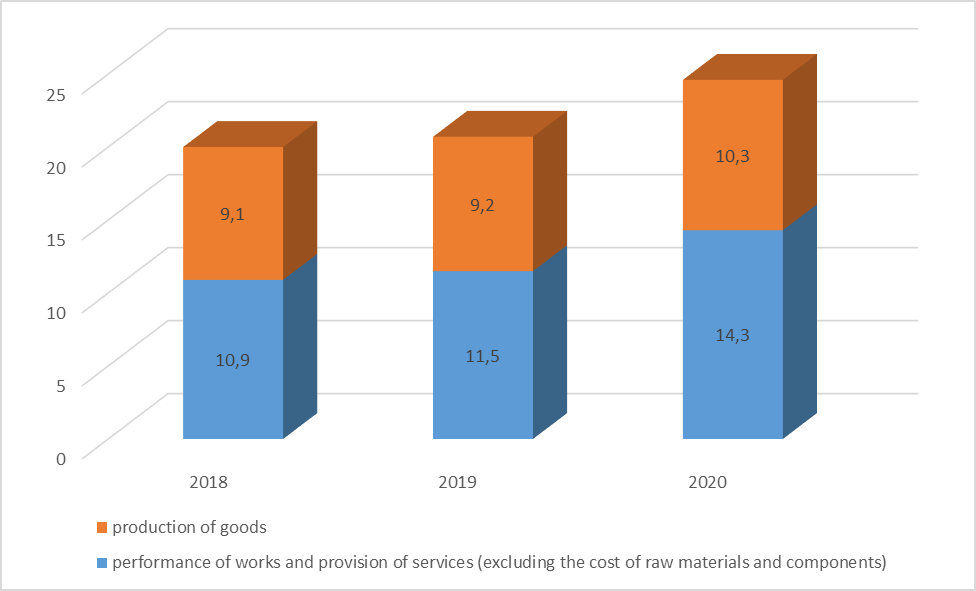
Fig. 1. The structure of products produced by penitentiary institutions in 2018-2020, bln. rubles
Source: statistical reporting of the Federal Penitentiary Service of Russia, authors’ calculations
Meanwhile, if the cost of production will be cleared from material costs (Fig. 2), which will give a more objective picture of the distribution of labor costs (and, as a consequence, overhead costs) between goods, on the one hand, and works and services, on the other, then the structure of products de facto turns into a service-oriented type (the ratio of 45%/55% in 2018 and 42%/58% in 2020).
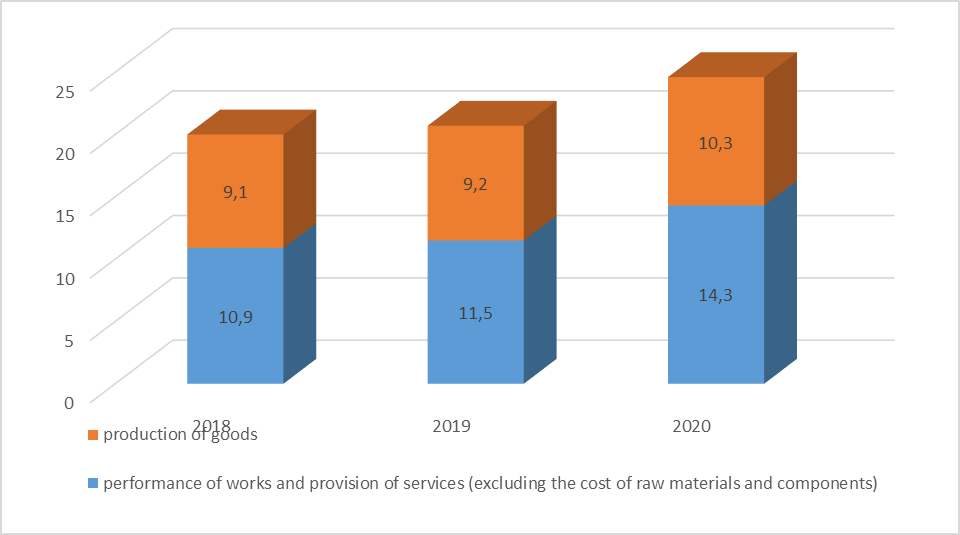
Fig. 2. The structure of products produced by penitentiary institutions in 2018-2020, bln. rubles (excluding the cost of raw materials and components)
Source: statistical reporting of the Federal Penitentiary Service of Russia, authors’ calculations
Second direction of the research – structural analysis by category of consumers of products. Considering this issue without distinguishing the segments of goods, works and services (Fig. 3), in the first approximation, we can conclude that two segments are quite stable in terms of volume – a segment of products for the needs of commercial organizations and a segment of products for state and municipal needs (mainly for the needs of the penitentiary system).
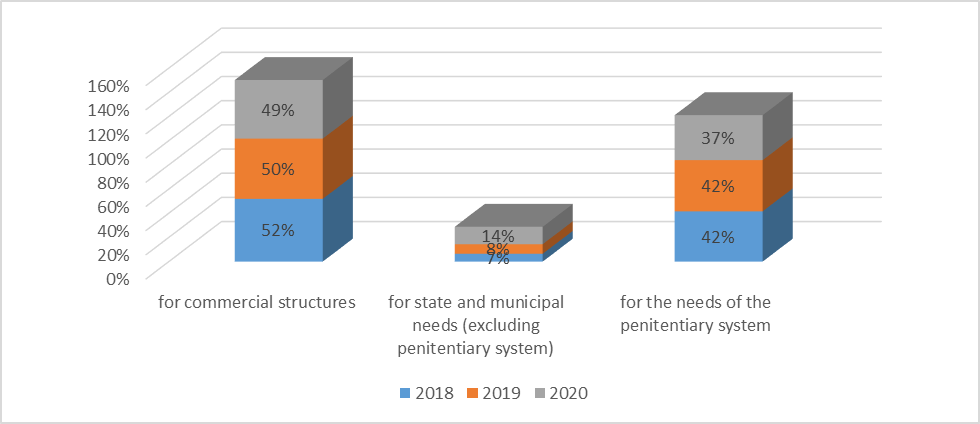
Fig. 3. The structure of products produced by penitentiary institutions (the main consumer groups) in 2018-2020, %
Source: statistical reporting of the Federal Penitentiary Service of Russia, authors’ calculations
However, in case of combining the two bases of structural analysis, a rather interesting picture opens up, allowing us to formulate more reasonable conclusions about which products and services are interesting to business. Figure 4 shows the structure of goods in the context of the main customers.
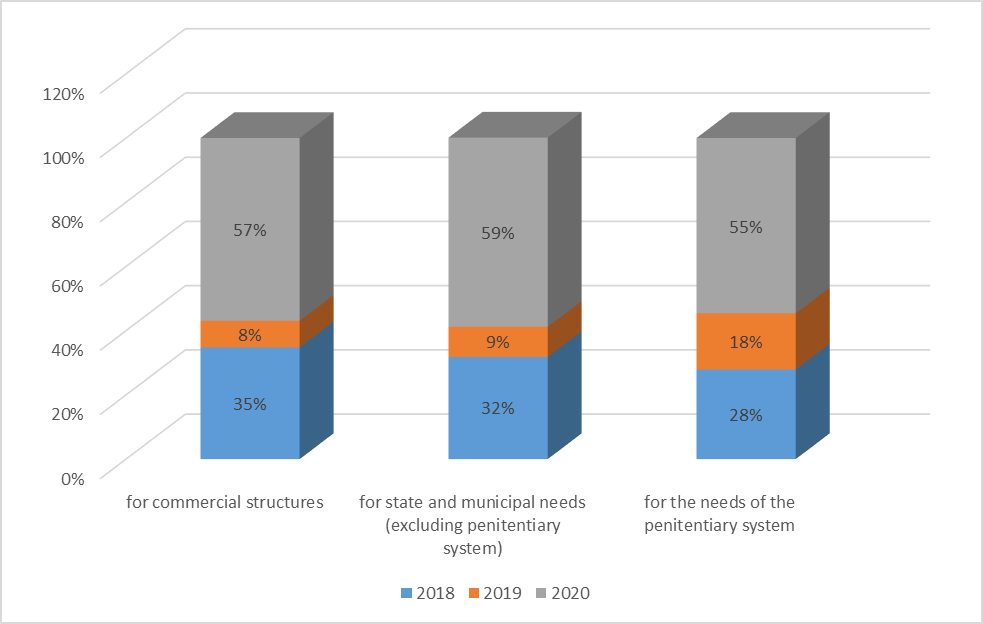
Fig. 4. Structure of goods produced by penitentiary institutions (the main consumer groups) in 2018-2020, %
Source: statistical reporting of the Federal Penitentiary Service of Russia, authors’ calculations
Main share of goods (more than a half) is produced by CI for penitentiary system needs. The portfolio of orders aimed at meeting the internal needs of the penitentiary system, with limited budget financing in recent years (2018 – 2020) has been formed in the range of 13-14 billion rubles, of which 12 billion rubles are goods. These are mainly agricultural products, food products, clothing, etc., whose supply contracts are carried out on the basis of Article 93 (Sec. 1, p. 11) of Federal Law No. 44-FZ dated 05.04.2013 "On the Contract System in the Field of procurement of goods, works, services for State and Municipal Needs" (hereinafter – 44-FZ) and Decree of the Government of the Russian Federation No. 1292 dated 26.12.2013 "On Approval of the List of Goods (Works, Services) Produced (performed, rendered) by institutions and enterprises of the penitentiary system, the purchase of which can be carried out by the customer from a single supplier (contractor, contractor)" (This resolution is a by-law implementing the norm of Article 10 of the Law of the Russian Federation No. 5473-1 dated 21.07.1993 "On institutions and bodies executing criminal penalties in the form of imprisonment". This article defines that in order to create conditions that ensure the involvement of convicts in labor, the Government of the Russian Federation is obliged to place orders for certain types of products, works and services to meet state needs at federal state unitary enterprises of the penitentiary system and its own production in CI).
It is important to note that the "recent" decree of the Government of the Russian Federation dated 28.05.2021 No. 821 expanded this list. In addition, a list of goods, works and services for which only in-system purchases can be carried out was approved. The state thereby creates a regulatory framework for the development of certain areas of production activities of the CI, simplifying contracting procedures and creating certain advantages for penitentiary producers.
Due to active measures at the state level (mainly in cooperation with the Federation Council), the volume of goods produced for other state and municipal customers increased almost 2.5 times in 2018-2020 – from 1.6 to 3.9 billion rubles. Certain subjects of the Russian Federation (in particular, the Republic of Karelia), when making purchases for the needs of public authorities, started to implement the practice according to which CI are considered as suppliers of products as a matter of priority, and only if they cannot fulfill these orders, other participants are involved in the contracting process [10; 18; 22].
In turn, the share of goods produced by CI for the needs of commercial structures decreased from 6.8 to 6.1 billion rubles, or, in relative terms, from one third to one quarter of the total volume of commodity output. The alleged reasons for this will be discussed in more detail later.
Analyzing the structure of works and services performed and rendered by the CI in the context of the main customers (Fig. 5), we see that only 20% of this segment is intended for state and municipal (including in-system) customers. Business takes the remaining 80%.
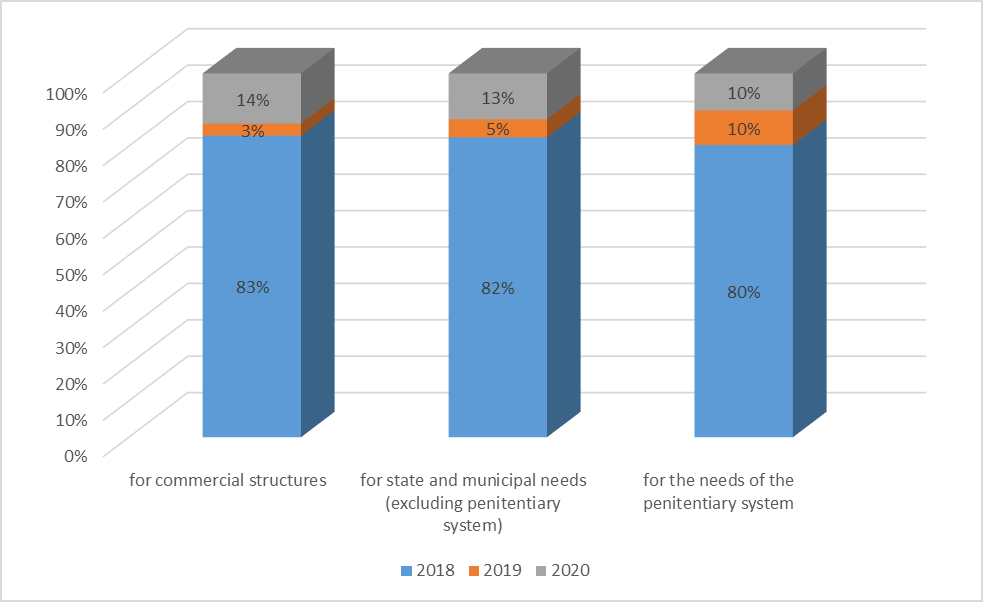
Fig. 5. The structure of works and services performed and rendered by penitentiary institutions (the main consumer groups) in 2018-2020, %
Source: statistical reporting of the Federal Penitentiary Service of Russia, authors’ calculations
DISCUSSION
The role of CI for business: seller or contractor?
It's time to answer the question: for what reasons do the economic relations between CI and commercial structures function in such a format? We will discuss some of them, while a very real scenario may be a combination of several reasons at once.
The first reason is the extremely weak competitive position of CI as an independent participant in market interaction.
CI as federal state institutions as "full-fledged" sellers of goods are significantly limited in their capabilities both from the side of legal regulation of activities (budget legislation, 44-FZ) and the possibilities of using economic instruments. CI practically do not participate (and some do not consider it as a possible scenario in principle) with competitive methods of determining suppliers (tenders, auctions, requests for quotations) for the needs of commercial organizations that are subject to the 223-FZ.
The specifics of the main activities of institutions do not provide for the necessary number of employees of contract services departments in the staffing table, not to mention the problem of matching the qualifications of existing employees with constantly increasing requirements [25]. As a result, high and unmanageable transaction costs (in particular, the costs of information retrieval and the costs of opportunistic behavior) negate even the most attractive offers in terms of production costs.
During the period of large-scale transformation of sales processes and, above all, the widespread distribution of online trading services and digital platforms, in the presence of template and formally functioning Internet sites on the platform of the territorial bodies of the Federal Penitentiary Service of Russia, only a limited number of IUS have real tools for remote trading (Examples include the website of the company "ELTI" (https://elti-k.ru /) – the production unit of the Correctional colony-1 in Kostroma region, which is quite successfully functioning on the market of electrical products, as well as the website of the Kazan Rebar Plant (http://ik2-kaz.ru /), the production unit of the Correctional colony-2 in the Republic of Tatarstan, operating in the market of shut-off pipe fittings).
Thus, the limited capabilities of both the main production facilities and the units serving it (repair, tool, energy, transport, warehouse, etc.), lagging behind competitors in the field of marketing, promotion and sale of products (acutely noticed, in particular, by Yu. Ezrokh [13]) significantly strengthen, the problem of the specificity of assets and require additional specialized investments to carry out independent marketing activities [16; 17; 19; 21; 24].
The second reason is the ex ante role of the contractor, a quasi–division in the business structure defined for the CI.
The opening of production facilities on the basis of a CI by commercial structures, accompanied by the transfer of production capacities from the first to the second, can be perceived as specialized investments in the first approximation. However, on our mind, this is much more similar to the realocation of resources.
Business copies in miniature the global model of transferring individual industries from more developed to less developed countries [23] and is ready to bear certain costs in an attempt to shift to others (in this case, to a CI) production and transaction costs associated with:
- operation of morally and physically worn–out industrial facilities and ensuring the necessary working conditions the personnel employed on them;
- more complex procedures for the import of raw materials into the territory of CI and the export of finished products (lengthy inspection and security procedures);
- difficulties in hiring qualified engineering and technical personnel to work in private production in the industrial zone of a CI;
- passing control and audit measures by the relevant bodies of the Federal Penitentiary Service of Russia, which are not typical for private business structures.
The third reason is that private business does not see the obvious advantages of interacting with CI
The advantages that were previously considered competitive for CI in terms of organizing interaction with private business are currently of no interest to it. In particular, we are talking about a lower level of remuneration for convicts compared to market rates, as well as the presence of a significant production infrastructure on the basis of CI (buildings, structures, access roads, utilities, etc.).
The lower level of convicts’ remuneration is repeatedly compensated by their lack of qualifications, work skills, negative attitude to socially useful work and other factors. It should also be taken into account the fact that an increase in the level of the minimum wage in modern conditions requires a corresponding increase in its productivity, which in conditions of penitentiary production is associated with investments in equipment. As the capital intensity of production increases, a logical question arises about the expediency of its placement in territories with excessive availability of labor resources.
Infrastructure facilities and communications are accumulating wear and tear and, as they become obsolete, they lose their attractiveness for private contractors. Investments in the renovation of the infrastructure of facilities that are on the balance sheet of state-owned institutions are a clear risk that is a deterrent for private business.
Increasing the attractiveness of partnership and interaction for private business is associated with the need to provide obvious competitive advantages for CI. The possibilities of joint execution of government orders, as well as access to participation in intra-system product deliveries can be considered here. However, the inability to obtain an in-system status for products manufactured on private facilities using convicts’ labor remains a deterrent.
What is business afraid of?
Currently, the main issue determining the parameters of interaction between CI and representatives of the business community is the legal basis for the placement of property (fixed assets) of a private partner at the facilities of the production sector of CI. The safest way, excluding any liability for officials of the CI in the future, is gratuitous use. Entrepreneurs consider such conditions to be risks of losing investments in expensive equipment. The reduction of such risks is associated with the use of outdated equipment and appropriate technological processes, which in turn do not allow the production of competitive products on the market.
At the same time, the involvement of convicts serving coercive works in private enterprises excludes such risks. However, the unemployment rate of this category of convicts even exceeds the unemployment rate in places of deprivation of liberty.
In this case, in our opinion, it is relevant to conduct an empirical study aimed on identifying the factors that deter private business from participating in partnership projects of interaction with the penitentiary institutions. This kind of research can be conducted in the form of a survey of a group of private entrepreneurs operating in municipalities with a shortage of labor resources.
CONCLUSION
In our opinion, the issues of developing productive interaction and partnership between representatives of the business community and the institutions of the criminal justice system are in the plane of creating regulatory conditions for the admission of private contractors to the public procurement market as a criminal justice enterprise, provided that all labor intensity is fully transferred to the contingent of convicts held in the IU-the subject of interaction.
This kind of approach is justified due to the following circumstances:
1. The federal budget is unable to finance the program for the rapid creation of 300-400 thousand modern jobs. It is also necessary to take into account the need to attract tens of thousands of highly qualified civil engineering and technical workers to the facilities of the production sector of the penitentiary system, which creates additional wage obligations, etc.
2. In many types of economic activity, there is an incomplete (50-70%) use of production capacities. The only exceptions are some types of production (sugar, flour, etc.). The creation of new production facilities on the basis of state-owned institutions will actually increase the underutilization of equipment used at domestic enterprises. These will be redundant capacities.
3. The public procurement market is not as competitive as its creators saw it. Its microeconomic parameters are far from free competition. Direct producers of goods (especially food) face difficulties working with budget funds. At the same time, all of the above circumstances open the way for numerous intermediary structures. Simplification of access to public procurement of private producers through their cooperation with the production sector of the penitentiary system – will provide state customers with direct reliable supplies of domestic producers.
At the same time, modern legislation does not provide for obviously simple schemes for organizing this kind of interaction. In our opinion, the issues of substantiating the necessary changes to the domestic regulatory framework should be defined as a promising direction for applying scientific efforts.
1. Радченко Е.П. Социально-экономические предпосылки формирования государственно-частного партнерства в российской пенитенциарной системе // Известия Иркутской государственной экономической академии. - 2013. - № 3. - С.110-112.
2. Седых В.А., Радченко Е.П. Экономическое обоснование эффективности развития государственно-частного партнерства в пенитенциарной системе некоторых зарубежных стран //Уголовно-исполнительная система: право, экономика, управление. 2020. - № 3. - С. 30-33.
3. Гаршанина М.А. О выборе организационных вариантов участия производственных подразделений учреждений ФСИН России в промышленной кооперации // Экономика и управление. - 2010. - № 9 (59). С. 85-89.
4. Козин М. Н. Пенитенциарная экономика России в условиях санкционных рисков: целевые ориентиры и последствия // Международный пенитенциарный журнал. 2017. Т. 3. № 1. С. 16-21.
5. Мошненко, О. В. К вопросу об эффективности производственного сектора уголовно-исполнительной системы // Человек: преступление и наказание. - 2017. - Т. 25(1-4), № 4. - С. 652-656.
6. Попова Т. В., Стулов С. А. Особенности ценообразования на продукцию производственного сектора уголовно-исполнительной системы // Ведомости уголовно-исполнительной системы. 2018. № 4 (191). С. 30-37.
7. Шамсунов С. Х. Проблемные вопросы производственного сектора уголовно-исполнительной системы // Ведомости уголовно-исполнительной системы. 2017. № 6 (181). С. 6-8.
8. Гарник С. В., Казакова В. А. Уголовно-исполнительная политика в сфере организации труда осужденных к лишению свободы // Человек: преступление и наказание. 2018. Т. 26 (1-4). № 1. С. 76-83.
9. Антонян Е. А. Привлечение осужденных к труду за рубежом // Человек: преступление и наказание. 2016. № 4. С. 21-24
10. Нефедкин В. И., Фадеева О. П. Государственно-частное партнерство в реальном измерении // ЭКО. 2020. № 1. С. 8-28. DOI:https://doi.org/10.30680/ECO0131-7652-2020-1-8-28
11. Матвеева Н.С. Государственно-частное партнерство в промышленном секторе уголовно-исполнительной системы России //Уголовно-исполнительная система: право, экономика, управление. 2020. - № 4. - С. 12-15.
12. Шамсунов С. Х. Частные тюрьмы в мире: нужны ли они современной России? //Уголовно-исполнительная система: право, экономика, управление. 2016. - № 3. - С. 25-28
13. Эзрох Ю.С. Производственный потенциал современной российской пенитенциарной системы: состояние и меры по развитию // Журнал Новой экономической ассоциации. - 2017. - № 3 (35). С. 126-143
14. Погудин О. А. Производство и труд в пенитенциарной системе: динамика кризиса и неопределенность будущего // ЭКО. 2017. № 12. С. 99-112.
15. Погудин О. А. «Трудовая революция» в уголовно-исполнительной системе: очередной миф или настоятельная необходимость // ЭКО. 2015. № 11. С. 169-183
16. Englander E.J. The Inside Contract System of Production and Organization: A Neglected Aspect of the History of the Firm // Labor History. 1987. Vol. 28. P.4429-4446. Available at: https://business.gwu.edu/sites/g/files/zaxdzs1611/f/7_Englander_Inside%20Contract%20System.pdf
17. Grossman, S.J., Hart, O.D. (1986). The costs and benefits of ownership: A theory of vertical and lateral integration. Journal of Political Economy 94(4): 691-719. doihttps://doi.org/10.1086/261404 Available at: https://dash.harvard.edu/bitstream/handle/1/3450060/Hart_CostsBenefits.pdf
18. Крюков В. А., Меджидова Д. Д. Арктические активы - от масштаба к трансформности // ЭКО. 2021. № 1. С. 8-39. DOI:https://doi.org/10.30680/ECO0131-7652-2021-1-8-39
19. Южаков В. Н., Добролюбова Е. И., Покида А. Н., Зыбуновская Н. В. Реформа госконтроля и «регуляторная гильотина»: что получилось с позиции бизнеса? // ЭКО. 2021. № 7. С. 151-170. DOI:https://doi.org/10.30680/ECO0131-7652-2021-7-151-170
20. Williamson, O. E. (1985). The Economic Institutions of Capitalism: Firms, Markets, Relational Contracting. New York: Free Press; London: Collier Macmillan, XIV, 1985. 450 p.
21. Nelson, R. R., Winter, S. G. An Evolutionary Theory of Economic Change. Cambridge, Mass.: Harvard University Press, XI, 1982. 437 p.
22. Radchenko, E. P., Shamsunov, S. H., Tishchenko, Y. Y., Pyrchenkova, G. S. Public-Private Partnership Projects in Increasing Efficiency of Penal Institutions Production Sector. European Proceedings of Social and Behavioral Sciences EpSBS. Krasnoyarsk Science and Technology City Hall. 2020. p. 443-451. DOI:https://doi.org/10.15405/epsbs.2020.10.03.50
23. Алексеев А. В. Российский обрабатывающий сектор - пора за флажки // ЭКО. 2021. № 8. С. 104-126. DOI: DOI:https://doi.org/10.30680/ECO0131-7652-2021-8-104-126
24. Розанова Н. М. Конкуренция сегодня: процесс или результат? // Мировая экономика и международные отношения. 2021. Т. 65. № 8. С. 5-13. DOI:https://doi.org/10.20542/0131-2227-2021-65-8-5-13
25. Мельников В. В., Литвинцева Г. П. Как и почему растут издержки при госзакупках в РФ // ЭКО. 2020. № 3. С. 30-43. DOI:https://doi.org/10.30680/ECO0131-7652-2020-3-30-43

